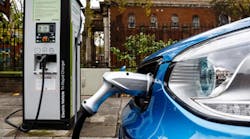California wants 5 million emission-free cars on the road by 2030. China, with a far larger population, wants 7 million electric vehicles by 2025. California has a cap-and-trade program to limit emissions from power plants, factories and fuel suppliers. China is launching a cap-and-trade system to lower fuel consumption and cut reliance on oil imports.
While the liberal and authoritarian politics of California and China are a study in contrasts, both places are taking a top-down approach to combating climate change by forcing a shift in energy and transportation. China, in fact, has modeled its electric car mandate on California’s program, following years of collaboration between officials on opposite sides of the Pacific.
“China has referenced and learned from California,” said Yunshi Wang, director of the China Center for Energy and Transportation at the University of California at Davis.
California Governor Jerry Brown met in China last year with President Xi Jinping. The talks focused on strategies to combat global warming and came shortly after President Donald Trump said the U.S. would pull out of the Paris climate accord. The ties between political leaders in China and California are all the more striking at a time when Washington and Beijing are on the cusp of a trade war.
Brown’s approach to energy policy may soon come under fire from the Trump administration, which is considering revoking California’s ability to set its own auto-emissions standards. U.S. automakers are trying to broker a compromise between California and Washington, worried that potential legal battles could lead to years of uncertainty regarding pollution-control policies. California, as the biggest auto market, tends to shape national policy; New York and several additional states that account for a third of U.S. vehicle sales have adopted California’s standards.
China and California, taken together, can exert a similar pull on the adoption of electric vehicles. China surpassed the U.S. in 2015 to become the world’s biggest market for electric cars, with sales of new-energy vehicles—a category that includes battery-powered, plug-in hybrid and fuel cell cars—possibly surpassing 1 million this year, according to the China Association of Automobile Manufacturers. California likewise makes up about half of the U.S. electric car market and now has more than 375,000 plug-ins on the road.
For the time being, as long as battery-charged cars are more expensive than gasoline-powered equivalents, the subsidies and mandates used by China, California and others to encourage adoption will remain vital. Electric cars accounted for less than 2% of worldwide new-car sales in 2017, according to Bloomberg New Energy Finance. Clean-energy advocates point to the example of solar and wind power, for which mandates helped drive demand that eventually pushed down costs to where renewable energy can compete on price with fossil fuel power plants.
“The hope is that these mandates and incentives will help create new knowledge that will drive down the costs and improve the quality—and, by doing so, will make the cost competitive with the internal combustion engine,” said Severin Borenstein, an energy expert and business professor at the University of California at Berkeley. “It’s a real stretch, because the internal combustion engine is really cost-competitive.”
Here’s a look at the policies California and China are using to usher in the electric car era:
Mandates for Automakers
California requires automakers that do business in the state to sell a certain number of electric cars through its zero-emission vehicle program. There are two ways to meet the requirement: Sell nonpolluting cars or buy surplus credits earned by competitors that do.
While the program has forced automakers to offer more electric car choices—more than 20 electric or plug-in hybrid models are now available, up from a handful a few years ago—there are indications that it also needs to be tweaked. Tesla Inc. has sold more than $1.2 billion in credits, and some automakers have stockpiled enough that they won’t need to sell electric cars for years.
China is adopting a similar program. Automakers in China must earn new-energy vehicle credits by producing electric cars, part of the country’s gradual phaseout of other subsidies. Carmakers will need to have at least 10% of vehicles sold in 2019 qualify for the credits. Companies that fail to meet the requirement can either pay fines or buy credits from rivals.
“China is using the stick more than the carrot approach,” said Steve Man, a Hong Kong-based analyst with Bloomberg Intelligence. “Those generous subsidies are nearly gone, and emission controls are getting more stringent.”
Incentives for Consumers
Consumers looking to buy an electric vehicle in California can take advantage of a $2,500 rebate. The state has spent about half a billion dollars on rebates for battery-powered, plug-in and fuel cell cars, according to state data, and Governor Brown has proposed extending subsidies as part of a $2.5 billion electric car initiative proposed in January. Combined with a $7,500 federal tax credit and manufacturer discounts, Californians can reduce their effective monthly lease payments for clean cars to almost zero, the Alliance of Automobile Manufacturers told the state last year.
China has been increasing subsidies to reward electric vehicles that can travel longer distances on a single charge. In a plan announced last month, the central government’s incentive for electric cars that have a range of 400 kilometers (249 miles) and beyond has been raised to 50,000 yuan (US$8,000), up from 44,000 yuan. At the same time, vehicles have to be able to go at least 150 kilometers on a single charge to be eligible for incentives, up from 100 kilometers previously.
Investing in Car Charging
One of the main bottlenecks to widespread adoption of electric cars is access to public charging stations. “You’ve got a lot of vehicles coming out, but not all consumers have access to charge up,” said Simon Mui, director of a program focused on California’s transportation policy at the Natural Resources Defense Council.
While California has the largest number of car-charging ports in the U.S., it has one of the lowest ratios of public outlets to electric cars in the country, according to an analysis by Beacon Economics provided by Next 10, an environment and policy group. Governor Brown’s latest plan also calls for $900 million spent, in part, on installing 250,000 electric charging stations, up from about 14,000 now.
China’s government has also been pushing construction of charging facilities nationwide. The country plans to add 600,000 stations this year, according to work plans of the National Energy Administration. The central government last month urged local governments to gradually shift subsidies away from helping drivers buy non-gasoline vehicles and toward the construction of charging facilities.
By Mark Chediak, John Lippert and Ying Tian




